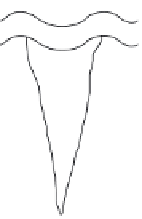Geoscience Reference
In-Depth Information
SOUTH
NORTH
Active layer
<2 m (6.6 ft)
Closed
talik
Large
lake
Open
talik
Active layer
<10 cm (4 in.)
10 m
45 m
Figure 17.34 Typical
periglacial landscapes.
Note the differences in
the spatial extent and
depth of permafrost
across this hypotheti-
cal cross section (not to
scale).
400 m
Discontinuous
permafrost
Through
talik
Unfrozen soil
and rock
Continuous
permafrost
Ground Ice and Associated Landforms
Within permafrost regions, distinct zones of frozen water occur
within the ground. These areas are referred to as
ground ice
and contain highly variable amounts of water, ranging from
near zero to completely saturated conditions. Areas of ground
ice expand and contract along freezing fronts, which are the
boundaries between frozen and unfrozen ground. As these ar-
eas expand and contract, they cause physical weathering of
the landscape through the frost action processes described in
Chapter 14. Remember that when water freezes, it expands by
about 9%. This expansion causes rocks to break along joint
lines. In addition, water expansion can cause soil to move
vertically or horizontally through the processes of
frost heaving
and
frost thrusting
, respectively.
Ground ice comes in many forms. The most basic kind of
ground ice is
pore ice
where water freezes in soil pore spaces.
Ground ice also occurs as
horizontal lenses
and veins of ice that
extend in random directions. A third kind of ground ice is an
ice
wedge
, which results when water enters a crack in the ground (Fig-
ure 17.35).
Segregated ice
is ground ice that is buried but grows
Frozen
active layer
Thawed
active layer
Open
crack
Crack fills
with water,
which freezes
Permafrost
Permafrost
Winter
Fall
After 500 years
Frozen
active layer
Thawed
active layer
Surface buckles
due to expanded
volume of ice
(a)
Open crack
now wider
Developing
ice
Permafrost
Figure 17.35 Formation of an ice wedge.
(a) An ice wedge in
northern Canada. (b) Sequence of steps in the formation of an
ice wedge. These features form when water penetrates an open
crack in the ground and freezes. Over time, repeated freezing
and thawing slowly cause the crack to expand, forming a wedge.
(
Source:
Modified from Arthur Lachenbruch, 1962, “Mechanics
of Thermal Contraction and Ice-Wedge Polygons in Permafrost,”
Geological Society of America Special Paper 70.)
Ice wedge
Permafrost
Winter
Fall
(b)
Ground ice
Distinct zones of frozen water that occur in
permafrost regions.





























